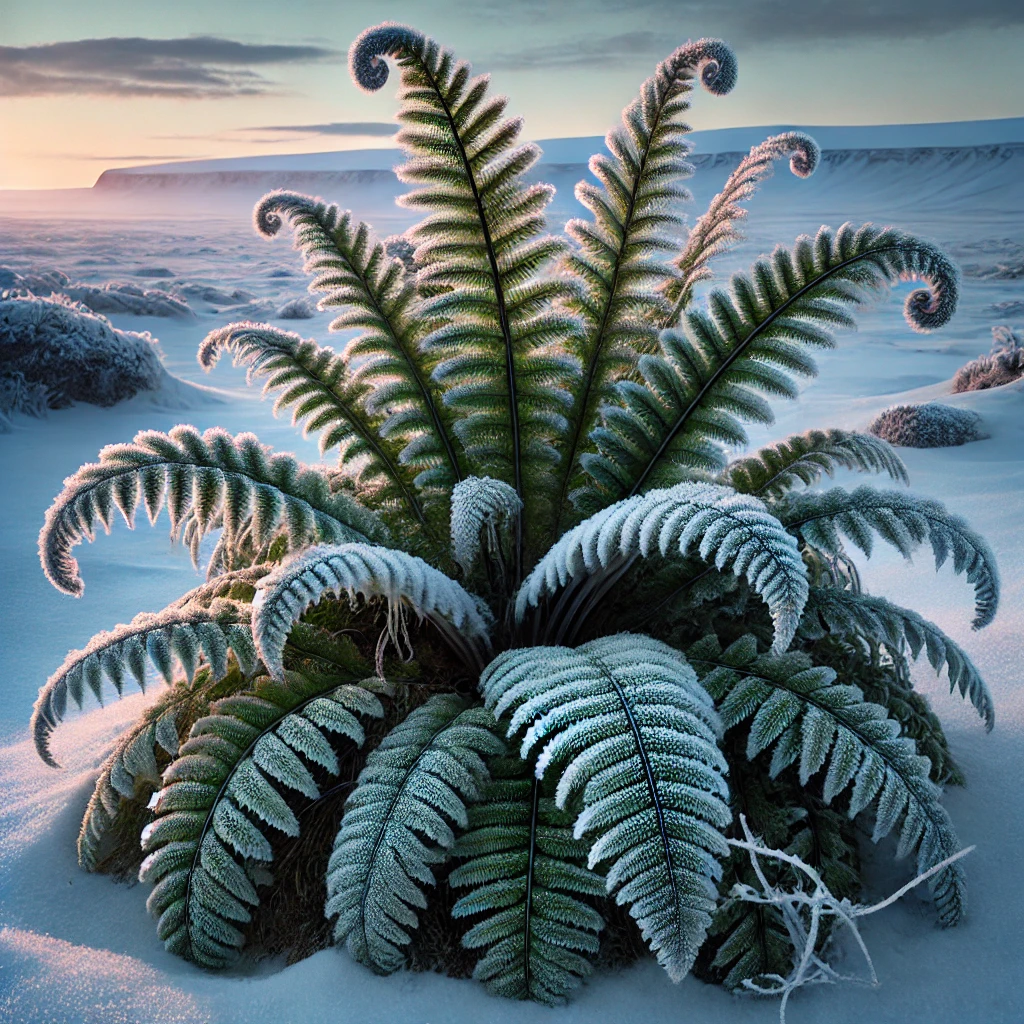Frostshade Ferns
The Frostshade Ferns are hardy, frost-resistant plants native to the icy tundras of northern Trura. Renowned for their resilience and unique properties, these ferns thrive in harsh, sub-zero environments where most vegetation cannot survive. Their role in the ecosystem, combined with their medicinal and cultural significance, makes them a vital part of Trura’s natural heritage.
Anatomy and Morphology
The Frostshade Fern has evolved to endure the freezing temperatures and limited sunlight of its native habitat. Its structure reflects a combination of toughness and adaptability.
Roots
- Type: Shallow but widespread, enabling the fern to absorb nutrients from the thin, frozen soil.
- Adaptations: Covered with a thin layer of frost-resistant tissues, the roots are highly efficient in moisture absorption, even in icy conditions.
Fronds
- Shape: Long and narrow, typically reaching lengths of 1 to 3 feet.
- Color: Deep green with silver or frost-like speckles on the surface, which shimmer faintly under moonlight or reflected sunlight.
- Surface: The fronds are coated with a waxy, insulating layer that prevents freezing and reduces water loss.
- Veins: Prominent and pale blue, giving the fronds a distinctive appearance and aiding in the transport of nutrients and water.
Spores
- Clusters: Found on the undersides of the fronds, the spores are pale blue and encased in a protective, frost-resistant coating.
- Dispersal: Released in late winter, carried by icy winds to propagate across the tundra.
Growth and Life Cycle
The Frostshade Fern is a perennial plant with a slow but steady growth pattern, adapted to the short growing season of its environment.
1. Germination Stage
- Spores settle in crevices or sheltered areas of the tundra, where they germinate during the brief summer when the ice melts.
2. Juvenile Stage
- Young ferns develop small, tightly curled fronds that gradually unfurl as they absorb nutrients. This stage can take several months due to the slow-growing nature of the plant.
3. Mature Stage
- Fully grown ferns exhibit their iconic silver-speckled fronds, reaching full maturity within 2 to 3 years.
- Mature ferns can live for decades, producing spores annually to ensure their survival and propagation.
Ecological Role
The Frostshade Fern is a keystone species in the tundra ecosystem, contributing to its stability and supporting various forms of life.
- Soil Stabilization: The fern’s shallow roots prevent soil erosion and help retain moisture in the otherwise dry and frozen tundra.
- Shelter: Provides cover for small mammals and insects, offering protection from predators and harsh weather.
- Nutrient Cycling: Decaying fronds enrich the thin soil, creating a more hospitable environment for other plant species.
- Temperature Regulation: The fern’s reflective fronds help reduce heat loss in its immediate surroundings, creating microclimates that support other life forms.
Medicinal Uses
The Frostshade Fern is highly valued for its medicinal properties, which are harnessed in traditional and modern remedies.
Frostbite Remedies
- The fronds contain a natural anti-inflammatory compound that is used to create salves for treating frostbite and minor burns.
Wound Healing
- Extracts from the fronds are applied to wounds as an antimicrobial agent, reducing infection and promoting faster healing.
Cold Resistance Tonics
- Distillations of the fern are consumed as tonics by travelers and adventurers, believed to enhance resistance to extreme cold.
Cultural Significance
The Frostshade Fern holds a special place in the traditions and beliefs of the northern Trurans.
Symbol of Resilience
- The fern is considered a symbol of endurance and adaptability, often featured in northern folklore and rituals celebrating survival in harsh conditions.
Sacred Offerings
- In Gidianist rituals, the fern is offered during winter ceremonies to honor the divine essence of Gidia and seek protection during the long, harsh winters.
Ornamental Use
- The shimmering fronds are sometimes preserved and used as decorations during festivals, symbolizing the beauty of resilience.
Practical Applications
Beyond its medicinal and cultural value, the Frostshade Fern has various practical uses:
Insulation Material
- The waxy coating of the fronds is harvested and processed into an insulating material for clothing and shelter, particularly by those living in the tundra regions.
Crafting
- The frost-speckled fronds are dried and woven into wreaths and ornaments, prized for their aesthetic appeal.
Trade
- Frostshade Fern extracts and preserved fronds are valuable trade items, sought after by apothecaries and artisans in warmer regions of Trura.
Conservation and Sustainability
Due to its ecological importance and cultural value, Trura has implemented measures to protect the Frostshade Fern:
- Sustainable Harvesting: Regulations ensure that fronds are harvested without harming the plant’s ability to reproduce and thrive.
- Protected Areas: Certain regions of the tundra are designated as sanctuaries, preserving large populations of the fern and their ecosystems.
- Community Stewardship: Local communities are encouraged to monitor and maintain fern populations, ensuring their longevity for future generations.
The Frostshade Fern embodies the beauty and resilience of Trura’s northern landscapes. Its ability to thrive in some of the most inhospitable environments reflects the enduring spirit of the Truran people and their deep connection to their natural world.



Comments